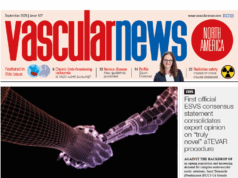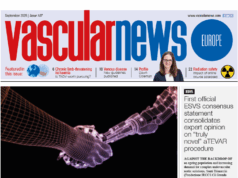 The European Society for Vascular Surgery (ESVS) has developed new guidelines for the care of patients with vascular trauma. The 2025 clinical practice guideline document was recently published as an open-access article in press in the European Journal of Vascular and Endovascular Surgery (EJVES).
The European Society for Vascular Surgery (ESVS) has developed new guidelines for the care of patients with vascular trauma. The 2025 clinical practice guideline document was recently published as an open-access article in press in the European Journal of Vascular and Endovascular Surgery (EJVES).
A writing committee consisting of first author Carl Magnus Wahlgren (Karolinska University Hospital, Stockholm, Sweden) and colleagues from across Europe has outlined a total of 105 recommendations.
The guidelines cover several topics, namely technical skill sets, bleeding control and restoration of perfusion, graft materials, and imaging; management of vascular trauma in the neck, thoracic aorta and thoracic outlet, abdomen, and upper and lower extremities; postoperative considerations after vascular trauma; and paediatric vascular trauma. Unresolved vascular trauma issues and patients’ perspectives are also discussed.
Wahlgren and team state that the guidelines “provide the most comprehensive, up-to-date, evidence-based advice to clinicians on the management of vascular trauma,” whilst acknowledging some limitations affecting their generalisability. “There is a general paucity of high-quality data and literature on vascular trauma management,” they write, noting that this applies to aspects relating to sex and ethnicity, but also conditions of low- and medium-income countries. “These limitations must be kept in mind when managing vascular trauma in different settings and environments.”
Ross Davenport (Barts Health NHS Trust, London, UK), a member of the guideline writing committee, tells Vascular News that the new document is the first set of European guidelines for vascular clinicians to guide care for injured patients with vascular trauma.
“As a writing committee, our intention was to produce a novel, practical and usable set of recommendations based on the breadth of evidence available,” he says.
“In this new vascular guideline,” Davenport continues, “readers will find a number of recommendations for system organisation and training, but for the first time we have proposed a new grading system for vascular injuries, evidence summaries on method and type of revascularisation, and a very clear recommendation on revascularisation times for ischaemic limbs (less than one hour from admission).”
On the timing of the guideline publication, Davenport remarks: “With major trauma, war and conflict continuing to rise globally, we hope this document will serve not only as an important reference to inform care but be the driver for research and innovation in the field of vascular trauma.”
Writing on X, formerly Twitter, guideline writing committee member Karim Brohi (The Royal London Hospital, London, UK) was enthusiastic about the impact of the new document. He remarked that the publication represents “a massive piece of work” and one that will “bring vascular trauma care kicking and screaming into the 21st century”.
Members of the wider vascular community have also responded positively to the guideline document’s publication. Writing on LinkedIn, Marian Broasca (Clinical Emergency Hospital Bucharest, Bucharest, Romania), commented: “Traumatology represents an extremely common pathology in all emergency hospitals. For this reason, the updated ESVS concept is not only welcome but also very necessary for improving practices in this field.”
Broasca added: “I highly recommend this material to all those interested in developing their expertise in vascular trauma management, considering it a valuable resource for all practitioners in the field.”
Read the full guidelines document here.













